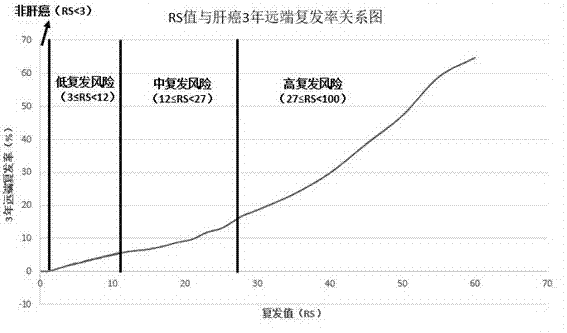Transcriptome-sequencing-based gene group for early diagnosis of liver cancer and prognostic evaluation and application thereof
A technology for early diagnosis and early liver cancer, applied in the biological field, can solve the problem of low specificity and achieve the effects of reducing misdiagnosis rate, improving diagnosis, and improving detection ability and efficiency
- Summary
- Abstract
- Description
- Claims
- Application Information
AI Technical Summary
Problems solved by technology
Method used
Image
Examples
Embodiment 1
[0056] Example 1 Screening of Gene Groups for Early Diagnosis and Prognostic Assessment of Primary Liver Cancer Based on Next Generation Sequencing Technology
[0057] From January 2008 to December 2008 in a tertiary hospital, a total of 200 patients with suspected liver cancer (single diameter ≤ 5 cm or the number of tumors less than 3, and all diameters ≤ 3 cm) were collected, and the postoperative diagnosis indicated focal tumors. There were 3 cases of nodular hyperplasia, 8 cases of atypical hyperplasia, and 2 cases of inflammatory nodules. There were 187 patients with early liver cancer and 13 cases of non-cancer patients. The isolated fresh tissues removed during the operation of the above 200 patients were made into paraffin tissue samples as required. Check as follows:
[0058] (1) Extraction of mRNA from paraffin tissue specimens (by QIAGEN RNeasy FFPE Kit)
[0059] 1) First trim the wax block with a blade;
Embodiment 2
[0122] Example 2 Diagnosis of early liver cancer and prognosis assessment based on gene group and RS value algorithm
[0123] Example 2 A total of 329 patients with early liver cancer (single diameter ≤ 5cm or number of tumors less than 3, and diameter ≤ 3cm) underwent surgery in a tertiary hospital from January 2010 to January 2011 were collected, and the postoperative diagnosis indicated localized liver cancer. There were 3 cases of focal nodular hyperplasia, 7 cases of atypical hyperplasia, and 4 cases of inflammatory nodules. According to the requirements, the isolated fresh tissue taken out of the patient's operation was made into a paraffin tissue sample, and the total RNA of the sample was extracted, reverse-transcribed into cDNA, and six GPC3, HSP70, GS, PIVKA-Ⅱ, GAPDH, and ACTB were detected in the sample by qPCR The expression level of the gene was calculated according to the RS value calculation formula in Example 1 to obtain the RS value of each patient. Comparing...
PUM
| Property | Measurement | Unit |
|---|---|---|
| Sensitivity | aaaaa | aaaaa |
| Sensitivity | aaaaa | aaaaa |
| Sensitivity | aaaaa | aaaaa |
Abstract
Description
Claims
Application Information
 Login to View More
Login to View More - R&D
- Intellectual Property
- Life Sciences
- Materials
- Tech Scout
- Unparalleled Data Quality
- Higher Quality Content
- 60% Fewer Hallucinations
Browse by: Latest US Patents, China's latest patents, Technical Efficacy Thesaurus, Application Domain, Technology Topic, Popular Technical Reports.
© 2025 PatSnap. All rights reserved.Legal|Privacy policy|Modern Slavery Act Transparency Statement|Sitemap|About US| Contact US: help@patsnap.com


